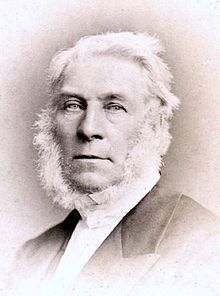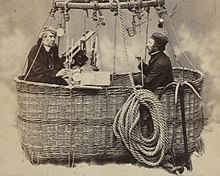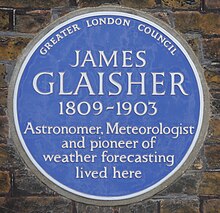| James Glaisher | |
|---|---|
 | |
| Born | (1809-04-07)7 April 1809 Rotherhithe, London, England |
| Died | 7 February 1903(1903-02-07) (aged 93) Croydon, Surrey, England |
| Spouse |
Cecilia Louisa Belville
(m. 1843) |
| Children | 3 (incl. James) |
| Scientific career | |
| Fields | Meteorology |
James Glaisher FRS (7 April 1809 – 7 February 1903) was an English meteorologist, aeronaut and astronomer.
Biography

Born in Rotherhithe, the son of a London watchmaker, Glaisher was a junior assistant at the Cambridge Observatory from 1833 to 1835 before moving to the Royal Observatory, Greenwich, where he served as Superintendent of the Department of Meteorology and Magnetism at Greenwich for 34 years.
In 1845, Glaisher published his dew point tables for the measurement of humidity. He was elected a Fellow of the Royal Society in June 1849.
He was a founding member of the Meteorological Society (1850) and the Aeronautical Society of Great Britain (1866). He was president of the Royal Meteorological Society from 1867 to 1868. Glaisher was elected a member of The Photographic Society, later the Royal Photographic Society, in 1854 and served as the society's president for 1869–1874 and 1875–1892. He remained a member until his death. He was also President of the Royal Microscopical Society. He is most famous as a pioneering balloonist. Between 1862 and 1866, usually with Henry Tracey Coxwell as his co-pilot, Glaisher made numerous ascents to measure the temperature and humidity of the atmosphere at the greatest altitudes attainable at that time.

Their ascent on 5 September 1862 broke the world record for altitude but he passed out around 8,800 metres (28,900 feet) before a reading could be taken. One of the pigeons making the trip with him died. Estimates suggest that he rose to more than 9,500 metres (31,200 feet) and as much as 10,900 metres (35,800 feet) above sea level. Glaisher lost consciousness during the ascent and Coxwell lost all sensation in his hands. The valve-line had become entangled so he was unable to release the mechanism; with great effort, he climbed onto the rigging and was finally able to release the vent before losing consciousness. This allowed the balloon to descend to a lower altitude.

Glaisher lived at 20 Dartmouth Hill, Blackheath, London, where there is a blue plaque in his memory.
The two made additional flights. According to the Smithsonian Institution, Glaisher "brought along delicate instruments to measure the temperature, barometric pressure and chemical composition of the air. He even recorded his own pulse at various altitudes".
In 1871, Glaisher arranged for the publication of his book about the balloon flights, Travels in the Air, a collection of reports from his experiments. To ensure that numerous members of the general public would learn from his experiences, he included "detailed drawings and maps, colorful accounts of his adventures and vivid descriptions of his precise observations", according to one report.
Glaisher was elected to the American Philosophical Society in 1895.
He died in Croydon, Surrey in 1903, aged 93.
Family
In 1843 he married Cecilia Louisa Belville, a daughter of Henry Belville, Assistant at the Royal Observatory, Greenwich. James and Cecilia had two sons: Ernest Glaisher and the mathematician James Whitbread Lee Glaisher (1848–1928), and one daughter: Cecilia Appelina (1845–1932).
Recognition
A lunar crater is named after him. The name was approved by the IAU in 1935.
In popular culture
The Aeronauts, released in 2019, includes a fictionalised account of the 5 September 1862 flight. The film depicts fictional pilot Amelia Wren (played by Felicity Jones), joining Glaisher (played by Eddie Redmayne) in an epic fight for survival while attempting to make discoveries in a gas balloon. The film omits Henry Coxwell entirely with Wren becoming the pilot.
A report in The Daily Telegraph quotes Keith Moore, Head of Library at the Royal Society as saying: "It’s a great shame that Henry isn’t portrayed because he performed very well and saved the life of a leading scientist".
Notes
- H. P. Hollis, "Glaisher, James (1809–1903)" Archived 19 November 2022 at the Wayback Machine, rev. J. Tucker, Oxford Dictionary of National Biography, Oxford University Press, 2004; online edition, Oct 2008. Retrieved 5 January 2009.
- Stratton, F. J. M. (1949). "The History of the Cambridge Observatories". Annals of the Solar Physics Observatory, Cambridge. I. OCLC 827977295.
- Chapman, Allan (2012). "Airy's Greenwich Staff". The Antiquarian Astronomer. 6. Society for the History of Astronomy: 4–18. Bibcode:2012AntAs...6....4C.
- ^ Hunt, John L. (1996). "James Glaisher FRS (1809–1903), Astronomer, Meteorologist and Pioneer of Weather Forecasting: 'A Venturesome Victorian'". Quarterly Journal of the Royal Astronomical Society. 37 (3). Royal Astronomical Society: 315–347. Bibcode:1996QJRAS..37..315H.
- "Search Results". catalogues.royalsociety.org. Retrieved 16 May 2021.
- Presidents 1853–2013. www.rps.org Archived 2 April 2014 at the Wayback Machine and http://rpsmembers.dmu.ac.uk/rps_results.php?mid=130 Archived 4 March 2016 at the Wayback Machine. Retrieved 6 March 2015.
- Appletons' annual cyclopaedia and register of important events of the year: 1862. New York: D. Appleton & Company. 1863. p. 186.
- Centennial of Flight. Archived 8 February 2011 at the Wayback Machine
- 1902 Encyclopedia Archived 29 August 2008 at the Wayback Machine.
- Bev Parker. "A Great Victorian Adventure".
- "The Victorians who flew as high as jumbo jets". BBC. 20 April 2016. Retrieved 25 January 2021.
only a stroke of luck at 37,000ft prevented them drifting up to their deaths at the edge of the atmosphere.
- "The True History of the Aeronauts Who Transformed Our View of the World Above". Smithsonian. 9 December 2019. Retrieved 25 January 2021.
only a stroke of luck at 37,000ft prevented them drifting up to their deaths at the edge of the atmosphere.
- ^ "The True History of the Aeronauts Who Transformed Our View of the World Above". Smithsonian. 9 December 2019. Retrieved 25 January 2021.
- "APS Member History". search.amphilsoc.org. Retrieved 14 March 2024.
- Glaisher crater Archived 13 January 2016 at the Wayback Machine, Gazetteer of Planetary Nomenclature, International Astronomical Union (IAU) Working Group for Planetary System Nomenclature (WGPSN). Retrieved June 2015.
- Wiseman, Andreas (15 August 2018). "Felicity Jones-Eddie Redmayne Ballooning Pic 'The Aeronauts' Under Way In UK, Amazon Releases Striking First-Look". Deadline Hollywood. Retrieved 18 August 2019.
- Malvern, Jack (16 August 2018). "Ballooning hero becomes a woman for new Eddie Redmayne film The Aeronauts". The Times.
- Bodkin, Henry (15 August 2018). "Ballooning hero 'airbrushed' from history to make way for female character in Eddie Redmayne film". The Telegraph.
References
- Tucker, Jennifer (1996). "Voyages of Discovery on Oceans of Air: Scientific Observation and the Image of Science in an Age of 'Balloonacy'". Osiris. 2nd series. 11 (Science in the Field): 144–176. doi:10.1086/368758. S2CID 143645467.
- Glaisher, James (1871). Travels in the Air. London: Bentley. OCLC 346024. Extract Archived 2 October 2010 at the Wayback Machine.
External links
- "Glaisher, James" . Encyclopædia Britannica (11th ed.). 1911.
- Royal Society citation.
- Newspaper cutting from New York Times, 1909.
- Details of 1862 balloon flight.
- The Victorians who flew as high as jumbo jets.
- NOAA photo library – Illus. from Glaisher's 1871 "Travels in the Air"; see #634–641.
- The Aeronauts at IMDb
 .
. - Works by James Glaisher at LibriVox (public domain audiobooks)

| Preceded byCharles Green and George Rush | Human altitude record 1862-1901 With: Henry Tracey Coxwell |
Succeeded byArthur Berson and Reinhard Süring |
- 1809 births
- 1903 deaths
- English aerospace engineers
- English balloonists
- English meteorologists
- English science writers
- Fellows of the Royal Society
- Presidents of the Royal Meteorological Society
- English male non-fiction writers
- Flight altitude record holders
- Balloon flight record holders
- British aviation record holders
- Glaisher family
- People from Rotherhithe
- Members of the American Philosophical Society